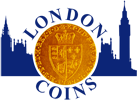Please browse the results of our past auctions using the navigation tools above.
Or browse our previous auctions using our text-based directory
Sell or auction your banknote collection
With London Coins selling your material could not be easier. We offer free appraisals, probate valuations, house visits, free collection of bulky material from your home, immediate cash offers and an auctioneering service.
If you have material to sell we offer a straightforward and easy to follow service which gives you the option of consigning your material to auction, or selling it to us direct for cash.
For further details please see our How To Sell Your Coins page and request our information pack.

























 RSS
RSS